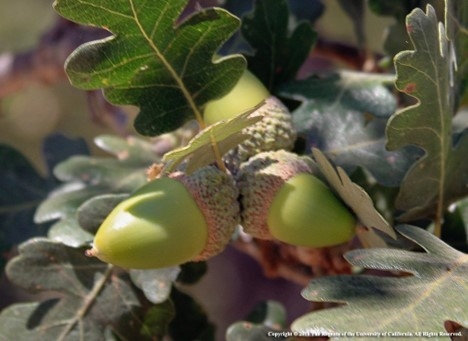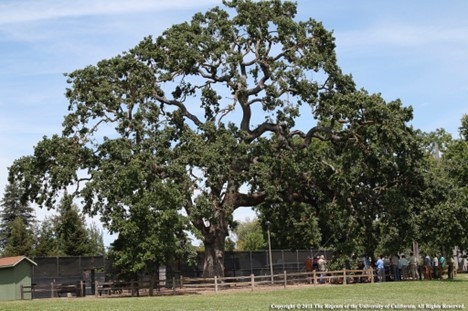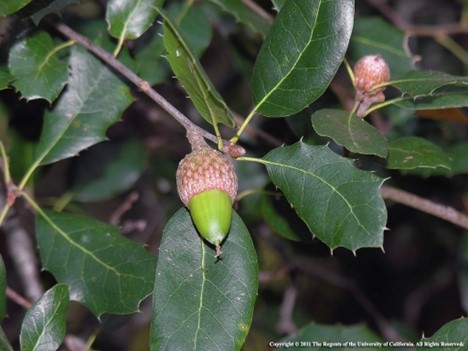Note: This was originally published in the Contra Costa Times.
Q: I know that acorns are the seeds of oak trees, but how do I plant them?
A: Oaks are an important part of the California landscape. If you are lucky enough to have oak trees on your property, or access to others' oak trees, you can collect the acorns and plant them. There are some simple things you can do to ensure a good start for your oaks.
Selecting the Site:
First of all, only plant a given oak species in areas where it naturally occurs or has grown in the past, and only use acorns from oaks growing in the same general environment as the planting site. Even within a species, there are genetic adaptations to different soils and climates. Use acorns from trees that grow as close to the planting site as possible.
Collecting Acorns:
Collect acorns in the early fall, when they are just starting to turn from green to brown and the first ones fall to the ground. Acorns collected from trees are generally healthier and more likely to germinate than those that have fallen to the ground. Pick them from the tree, twist off the caps (they should come off easily) and immediately put the acorns in the refrigerator to slow their metabolic activity.
If you collect them from the ground, discard any that are broken, cracked, very small, or lightweight, and soak them for a day in water, discarding any that float. Then dry them off and put them in plastic bags in the refrigerator.
Storing Acorns:
Although they can be planted right away, acorns that have been stored in the refrigerator for one month have higher germination rates than those planted right after collecting. Check them for mold, and if any mold develops, rinse it off, dry the acorns, and put them back in the refrigerator in plastic bags. Leaving part of the bag open at the end helps to reduce mold growth. If you see white tips emerging from the pointed end of the acorns during storage, it's best to plant them right away. That's the start of the root system emerging, and it can turn dark and mushy if left in storage.
Planting Your Acorns:
The best time to plant the acorns is from November after the first rain to early March. However, earlier is better to give them more time to grow before hot weather arrives.
Plant them in full sun. Keep the eventual height and canopy size of the tree in mind when you choose a location. Loose, well- drained soil is best, and the area should be fairly free of weeds.
Plant the acorns one half to one inch below the soil surface. Dig a hole several inches deep then partially backfill it. Place the acorns on their sides in the holes and cover with soil. If they've already started to germinate, plant them root down, being careful not to break the root tip. If you have a lot of nearby pocket gopher or ground squirrel activity, you can give the acorns a better chance by planting them two inches deep, but don't go any deeper than that or the acorns will rot.
You can also start the acorns in containers and plant the seedlings later. For information about this method, see the UC web page, How to Grow California Oaks (https://oaks.cnr.berkeley.edu/how-to-grow-california-oaks/).
Caring for Your Trees:
Weeds, especially grasses, will out-compete oak seedlings for sun, water and nutrients, so keep a two-to-three-foot radius around each seedling clear of weeds. Remove weeds by hand or with a hoe. Mulch suppresses weed growth and helps conserve soil moisture. Bark chips, straw, compost, or paper can be used.
Oaks develop vigorous and large root systems—that's how they survive drought. If the rains are very light, one or two deep supplemental waterings in late winter and early spring can help the seedlings survive through their first summer.
Acorns and oak seedlings are an important food source for rabbits, insects, mice and other animals. A variety of protective devices can be used to prevent their damage.
With some encouragement and protection, your seedlings will be well on their way to becoming oak trees. You may not live to see them mature, but future generations will enjoy these magnificent trees.
Help Desk of the UC Master Gardeners of Contra Costa County (EM)


